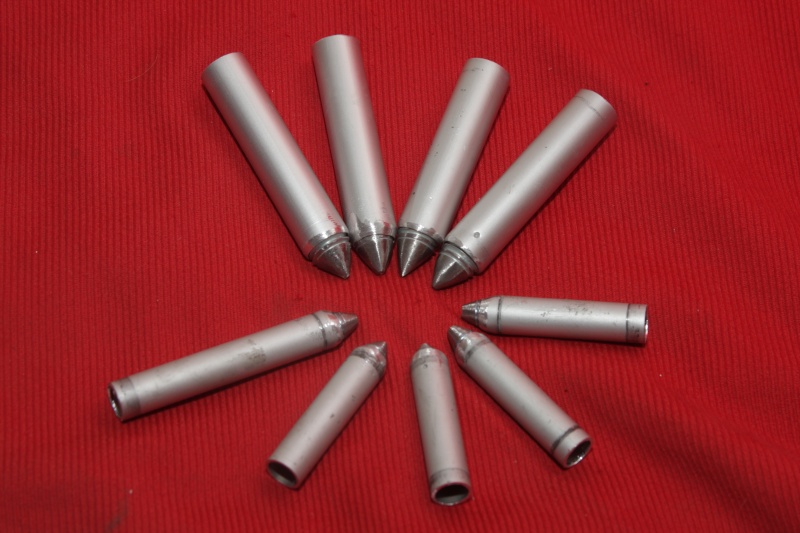The gun in 16mm not being striped I did not do that:
Ammunition very stable, skirt aluminum and point steel



Striped = RifledThe gun in 16mm not being striped I did not do that:

As Brian mentioned, high velocity does mean the projectile has less time to tumble before it hits the target, also worth nothing that plywood is a relatively hard target so other forces come into play, see the attached segment from one of my artillery books.The holes it made in the plywood were perfectly round.
The cross section is roundAlthough that really is a short arrow..not a " round" ...
Taking the maximum diameter of all projectiles being 6mm as a reference the dimensions can be worked out from the photos, I tried to take more vertical shots now.Next time post a picture of both at the same time.
That way we can observe the difference in the CG points.
6mm OD 5mm ID, I'm just using parts from my scrap box - remember this is just to play with projectile shapes, not meant for production.What are the dimensions on that aluminium rod? How does the linear mass density compare to that of UHMWPE or Delrin? I think you'd want to continue trying to use plastics; I'm pretty sure aluminium rods (hollow or not) will get pricey...
I was referring to the Gyrojet ;PRead the article - they state explicitly that it is drag stabilised
That's pretty much what happened, read on. Duane postulated that the muzzle blast might be deflecting the conical tailed projectiles, I intend to try using a wad and see if it makes a difference.That will reduce base drag (which will shift the CP forward) and add weight to the back (which will shift CG to the back) so it can f### things up
Very nice!Here the ammunition which I fire with my PAC 3000psi cal 50 (12.7mm) and cal 16mm
Well we already know that a tube capped and weighted on one end makes a stable projectile - my contention is it's not very aerodynamic, but what I've found so far is something that maybe should have been obvious from the beginning - reducing drag also reduces the efficiency of drag stabilisationSeems like the quest is over...but again..those are shot at pretty high velocity.
hectmarr wrote:You have to make many weapons, because this field is long and short life


The velocity was about 90-100 meters per second. Does that classify as high?As Brian mentioned, high velocity does mean the projectile has less time to tumble before it hits the target, also worth nothing that plywood is a relatively hard target so other forces come into play, see the attached segment from one of my artillery books.

Shoot it at a sheet of cardboard a bit further away, far enough for the muzzle blast not to influence the target.Labtecpower wrote:How would I be able to see if it tumbles? shooting it at a lower pressure into a sandbag?
hectmarr wrote:You have to make many weapons, because this field is long and short life




The quest for what though... These projectiles may be stable but probably have reasonably high drag too, not necessarily any good for long range.Seems like the quest is over.
Very nice ammo.Petitlu wrote:In 16mm:
overall length: 80mm
Length skirt aluminum: 70mm
threaded rod steel: 30mm of which 20mm inside
Weight: 35g
That's why fins are good, very little drag while flying straight but high drag if the projectile wobbles off axis.reducing drag also reduces the efficiency of drag stabilisation